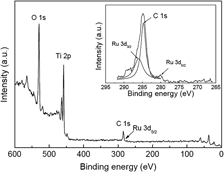Crossref Citations
This article has been cited by the following publications. This list is generated based on data provided by
Crossref.
Dendooven, Jolien
Devloo-Casier, Kilian
Levrau, Elisabeth
Van Hove, Robbert
Pulinthanathu Sree, Sreeprasanth
Baklanov, Mikhail R.
Martens, Johan A.
and
Detavernier, Christophe
2012.
In Situ Monitoring of Atomic Layer Deposition in Nanoporous Thin Films Using Ellipsometric Porosimetry.
Langmuir,
Vol. 28,
Issue. 8,
p.
3852.
Rabani, Joseph
and
Goldstein, Sara
2013.
Environmental Photochemistry Part III.
Vol. 35,
Issue. ,
p.
115.
Dahl, Michael
Liu, Yiding
and
Yin, Yadong
2014.
Composite Titanium Dioxide Nanomaterials.
Chemical Reviews,
Vol. 114,
Issue. 19,
p.
9853.
Liu, Jingting
and
Zhang, Jingbo
2016.
Photocatalytic activity enhancement of TiO2 nanocrystalline thin film with surface modification of poly-3-hexylthiophene by in situ polymerization.
Journal of Materials Research,
Vol. 31,
Issue. 10,
p.
1448.
Malyukov, V P
and
Vorobyev, K A
2019.
Combined development of oil and salt layers in an oil field.
IOP Conference Series: Materials Science and Engineering,
Vol. 675,
Issue. 1,
p.
012036.
Yang, Mei
Zhang, Wenhao
Chen, Jin
Li, Yang
Huang, Tingyu
Tang, Ning
and
Li, Pengcheng
2019.
Corrosion and Electrochemical Impedance Properties of Ti6Al4V Alloy and Ti-3Zr-2Sn-3Mo-25Nb Alloy Treated by Micro-arc Oxidation Process.
International Journal of Electrochemical Science,
Vol. 14,
Issue. 9,
p.
8699.
Boudjemaa, Amel
and
Gómez-Ruiz, Santiago
2020.
Environmental Nanotechnology Volume 4.
Vol. 32,
Issue. ,
p.
215.
Satapathy, P.
Pfuch, A.
Grunwald, R.
and
Das, S. K.
2020.
Enhancement of photocatalytic activity by femtosecond-laser induced periodic surface structures of Si.
Journal of Semiconductors,
Vol. 41,
Issue. 3,
p.
032303.
Mylarappa, M.
Chandruvasan, S.
and
Sandhya, R.
2024.
Development of rGO/RuO2 nanocomposite for voltammetric sensors, dye degradation and antioxidant studies.
Materials Chemistry and Physics,
Vol. 316,
Issue. ,
p.
129104.
